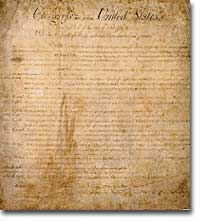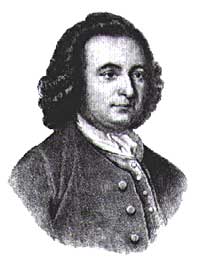2d. The Bill of Rights

By working to get the Bill of Rights passed, James Madison continued his support of Jefferson's policies. Jefferson supported the Constitution under the condition that basic human rights would be protected through a series of amendments.
Understandably, any people that fought a revolution over "taxation without representation" would be cautious about the new Constitution created in 1787. For example, famous Virginian Patrick Henry refused to attend the Convention because he "smelt a rat."
States cherished their new freedom from British control, and ratification of the Constitution by state legislatures was by no means certain. All thirteen states finally ratified by 1790, but only with the addition of ten amendments, known as the Bill of Rights, that guaranteed citizens' rights and freedoms.
The Debate over Ratification
The debate polarized the new nation. Those who supported the Constitution became known as federalists and those who opposed its ratification were called antifederalists. The federalists supported a strong national government to preserve order. The antifederalists favored strong state governments and believed that the national government created by the Constitution was too strong.
| Political Beliefs | Believed the Union would fail without a strong central government | Wanted strong state governments (closer to the people) |
| Who Should Rule | Thought that elites were most fit to govern | Believed that ordinary people should have great input into government |
| Trusting the People | Distrusted rule by the people | Distrusted elites; thought they were corrupt |
| Who were they? | Property owners, landed wealthy, well-to-do | Small farmers, shopkeepers, laborers, merchants |
In many ways the argument was the same old debate about the proper balance between order and liberty. Alexander Hamilton, James Madison, and John Jay wrote compelling arguments in favor of ratification in a series of essays known as the Federalist Papers. There were probably more antifederalists in America, but the federalists were better organized, controlled more newspapers, and were in greater positions of power. The two sides finally reached an acceptable compromise when they agreed to add some amendments to the Constitution that protected individual liberties and rights.
The Bill of Rights

The piece of parchment that is called the Bill of Rights is actually a joint resolution of the House and Senate proposing twelve amendments to the Constitution. The final number of accepted amendments was ten, and those became known as the Bill of Rights.
In 1789 Virginian James Madison submitted twelve amendments to Congress. His intention was to answer the criticisms of the antifederalists. The states ratified all but two of them — one to authorize the enlargement of the House of Representatives and one to prevent members of the House from raising their own salaries until after an election had taken place. The remaining ten amendments, known as the Bill of Rights, were ratified in 1791.
They put limits on the national government's right to control specific civil liberties and rights, many of which were already protected by some of the state constitutions. Liberties protected included freedom of speech, press, religion, and assembly (First Amendment). The Bill of Rights also provided safeguards for those accused of crimes. Two amendments — the right to bear arms (Second Amendment) and the right to refuse to have soldiers quartered in your home (Third Amendment) — were clearly reactions to British rule. The antifederalists were pleased by the addition of the Tenth Amendment, which declared that all powers not expressly granted to Congress were reserved to the states.

George Mason was one of the leading figures in creating the Bill of Rights. After storming out of the Constitutional Convention because the Constitution didn't contain a declaration of human rights, he worked to pass amendments that would protect citizens from an intrusive government.
Over the years the Bill of Rights has become an important core of American values. The compromise that created the Bill of Rights also defined what Americans would come to cherish above almost all else. Together with the Declaration of Independence and the Constitution, the Bill of Rights helps to define the American political system and the government's relationship to its citizens.







